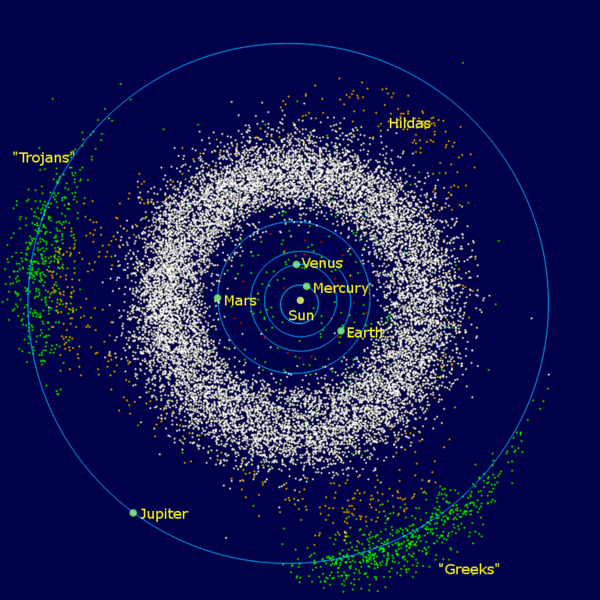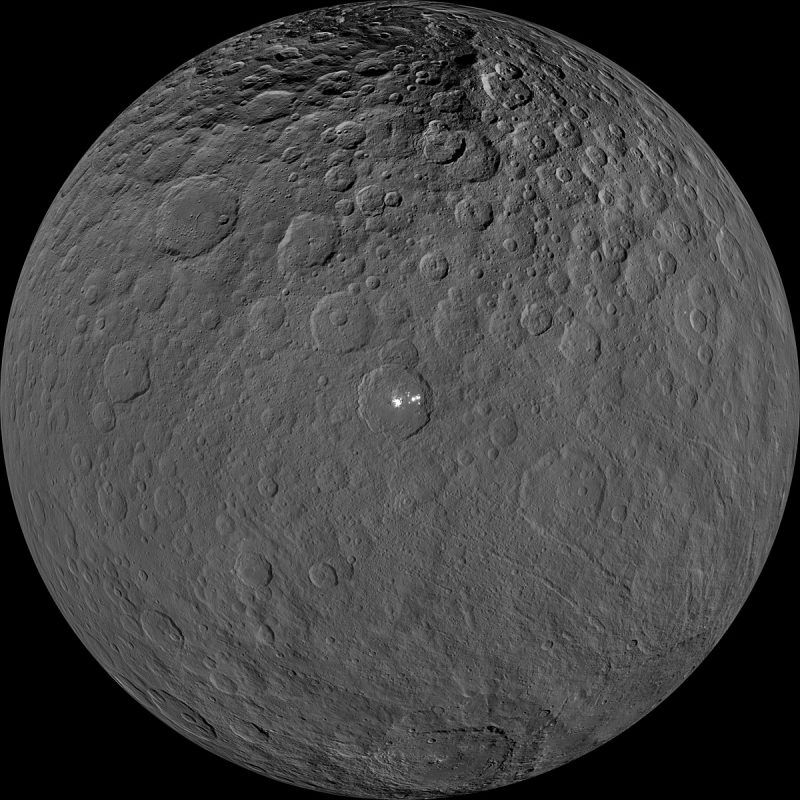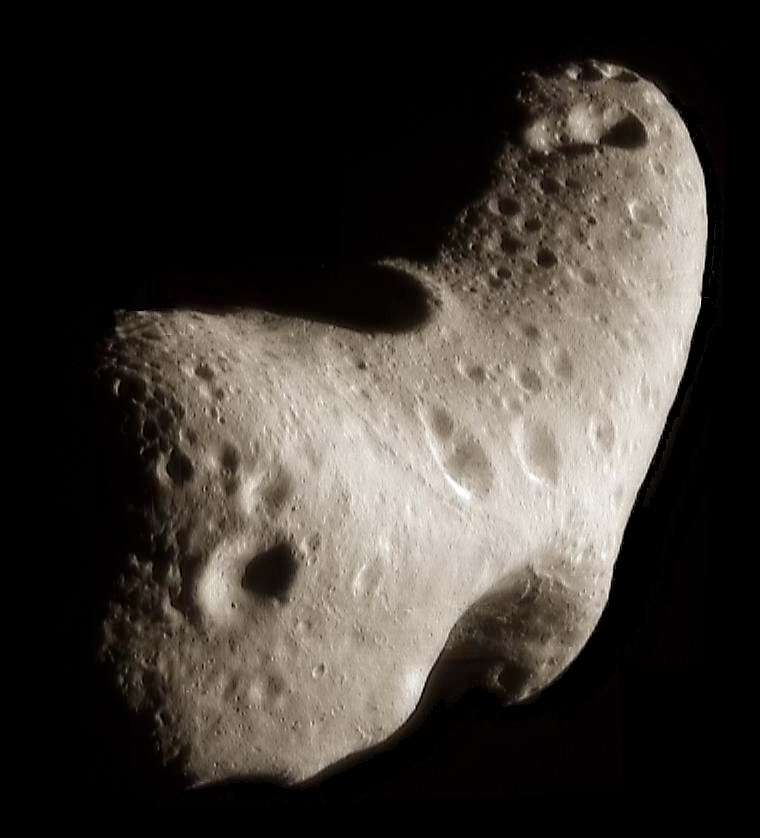
Meet the asteroid belt, a place in our solar system where small bodies – mostly rocky and some metallic – orbit the sun. Sometimes scientists call these little worlds minor planets. They move mostly between the orbits of the fourth planet Mars and fifth planet Jupiter. Astronomers once thought they were leftovers of a rocky planet that Jupiter’s gravity tore apart long ago. Now, most astronomers think the asteroid belt is just rubble that Jupiter’s gravity prevented from ever coalescing into a planet. Thus, the asteroids are likely simply remnants from the creation of our solar system 4.6 billion years ago.
The word asteroid means starlike. Asteroids got this name because, when astronomers first discovered them in the early 1800s, they thought they looked like stars. And yet their movement was separate from stars. Because they are closer to us, they move against the starry backdrop. This showed asteroids to be something other than stars.
Asteroids by the millions
While the graphic may make it seem like the asteroid belt is teeming with debris, if you lumped all the material together it would only create a body smaller than Earth’s moon.
The asteroid belt contains objects that vary wildly in size. It has one to two million asteroids more than half a mile (about a km) across. Plus, the asteroid belt contains untold millions of smaller ones, some probably no bigger than pebbles. In 1801, the astronomer Giuseppe Piazzi spotted the first asteroid to be discovered, which is also the biggest object in the asteroid belt. It is 1 Ceres, which measures some 587 miles (945 km). The International Astronomical Union has reclassified Ceres from an asteroid to a dwarf planet.

Distances in the asteroid belt
Outer space is vast. And thus, despite there being many millions (possibly billions) of objects in the asteroid belt, the average distance between them is 600,000 miles (about a million km). This means that spacecraft can fly through the asteroid belt without colliding with any asteroids. (Although, obviously, a chance collision is never completely out of the realm of possibility and bad luck.) The asteroid belt is certainly nothing like the densely packed fields depicted in fantasies such as “Star Wars” and its ilk.
Standing on any asteroid in the belt, you would likely be unable to see any other asteroids, because of their distance.
The asteroid belt lies between 2.2 and 3.2 astronomical units (AU) from our sun. One AU is the distance between the Earth and sun. So the width of the asteroid belt is roughly 1 AU, or 92 million miles (150 million km).
Its thickness is similarly about 1 AU.

Asteroids in and out of the main belt
The asteroid belt is often called the main belt to distinguish it from other, smaller groups of asteroids in the solar system such as the Lagrangians (for example, Trojan asteroids orbiting in Jupiter’s orbit around the sun) and Centaurs in the outer solar system.
What scientists once thought was a homogeneous belt is now known to be slightly more complicated. There are different and distinct zones within the main belt asteroids, especially at its edges, where astronomers now recognize the Hungaria group at the inner edge and the Cybele asteroids at the outer. Toward the middle of the belt there is the highly inclined Phocaea family.
In addition, astronomers have established that the age of asteroids in the main belt also varies. They’ve now classified several asteroid groupings by their age including the Karin family, a group of about 90 main-belt asteroids that share an orbit and may have come from a single object an estimated 5.7 million years ago. And there is the Veritas family, from an estimated 8.3 million years ago. A very recent group is the Datura family, dating from a collision just 530,000 years ago.

Bottom line: The asteroid belt is a region of our solar system – between the orbits of Mars and Jupiter – where many small bodies orbit our sun.
The post The asteroid belt contains solar system remnants first appeared on EarthSky.
from EarthSky https://ift.tt/3b8nnCG

Meet the asteroid belt, a place in our solar system where small bodies – mostly rocky and some metallic – orbit the sun. Sometimes scientists call these little worlds minor planets. They move mostly between the orbits of the fourth planet Mars and fifth planet Jupiter. Astronomers once thought they were leftovers of a rocky planet that Jupiter’s gravity tore apart long ago. Now, most astronomers think the asteroid belt is just rubble that Jupiter’s gravity prevented from ever coalescing into a planet. Thus, the asteroids are likely simply remnants from the creation of our solar system 4.6 billion years ago.
The word asteroid means starlike. Asteroids got this name because, when astronomers first discovered them in the early 1800s, they thought they looked like stars. And yet their movement was separate from stars. Because they are closer to us, they move against the starry backdrop. This showed asteroids to be something other than stars.
Asteroids by the millions
While the graphic may make it seem like the asteroid belt is teeming with debris, if you lumped all the material together it would only create a body smaller than Earth’s moon.
The asteroid belt contains objects that vary wildly in size. It has one to two million asteroids more than half a mile (about a km) across. Plus, the asteroid belt contains untold millions of smaller ones, some probably no bigger than pebbles. In 1801, the astronomer Giuseppe Piazzi spotted the first asteroid to be discovered, which is also the biggest object in the asteroid belt. It is 1 Ceres, which measures some 587 miles (945 km). The International Astronomical Union has reclassified Ceres from an asteroid to a dwarf planet.

Distances in the asteroid belt
Outer space is vast. And thus, despite there being many millions (possibly billions) of objects in the asteroid belt, the average distance between them is 600,000 miles (about a million km). This means that spacecraft can fly through the asteroid belt without colliding with any asteroids. (Although, obviously, a chance collision is never completely out of the realm of possibility and bad luck.) The asteroid belt is certainly nothing like the densely packed fields depicted in fantasies such as “Star Wars” and its ilk.
Standing on any asteroid in the belt, you would likely be unable to see any other asteroids, because of their distance.
The asteroid belt lies between 2.2 and 3.2 astronomical units (AU) from our sun. One AU is the distance between the Earth and sun. So the width of the asteroid belt is roughly 1 AU, or 92 million miles (150 million km).
Its thickness is similarly about 1 AU.

Asteroids in and out of the main belt
The asteroid belt is often called the main belt to distinguish it from other, smaller groups of asteroids in the solar system such as the Lagrangians (for example, Trojan asteroids orbiting in Jupiter’s orbit around the sun) and Centaurs in the outer solar system.
What scientists once thought was a homogeneous belt is now known to be slightly more complicated. There are different and distinct zones within the main belt asteroids, especially at its edges, where astronomers now recognize the Hungaria group at the inner edge and the Cybele asteroids at the outer. Toward the middle of the belt there is the highly inclined Phocaea family.
In addition, astronomers have established that the age of asteroids in the main belt also varies. They’ve now classified several asteroid groupings by their age including the Karin family, a group of about 90 main-belt asteroids that share an orbit and may have come from a single object an estimated 5.7 million years ago. And there is the Veritas family, from an estimated 8.3 million years ago. A very recent group is the Datura family, dating from a collision just 530,000 years ago.

Bottom line: The asteroid belt is a region of our solar system – between the orbits of Mars and Jupiter – where many small bodies orbit our sun.
The post The asteroid belt contains solar system remnants first appeared on EarthSky.
from EarthSky https://ift.tt/3b8nnCG

Aucun commentaire:
Enregistrer un commentaire